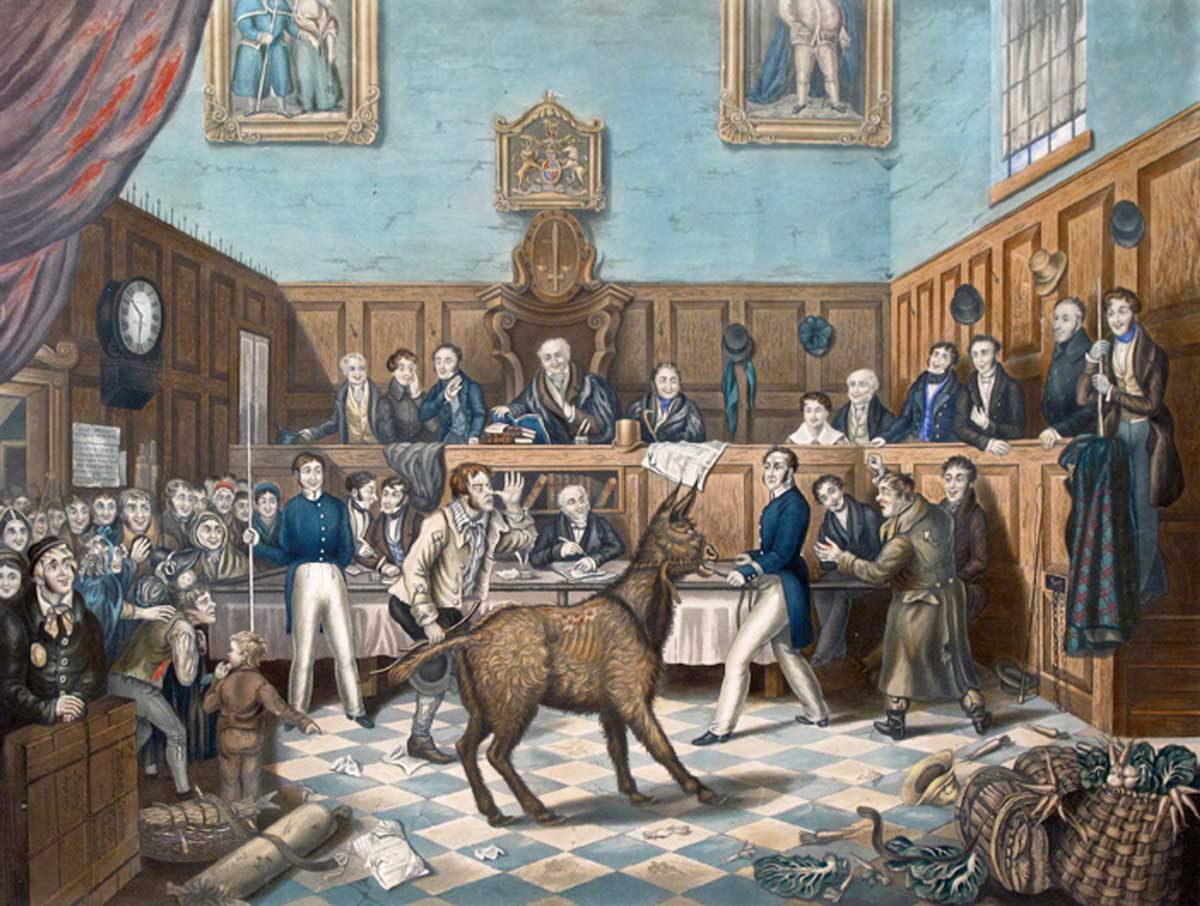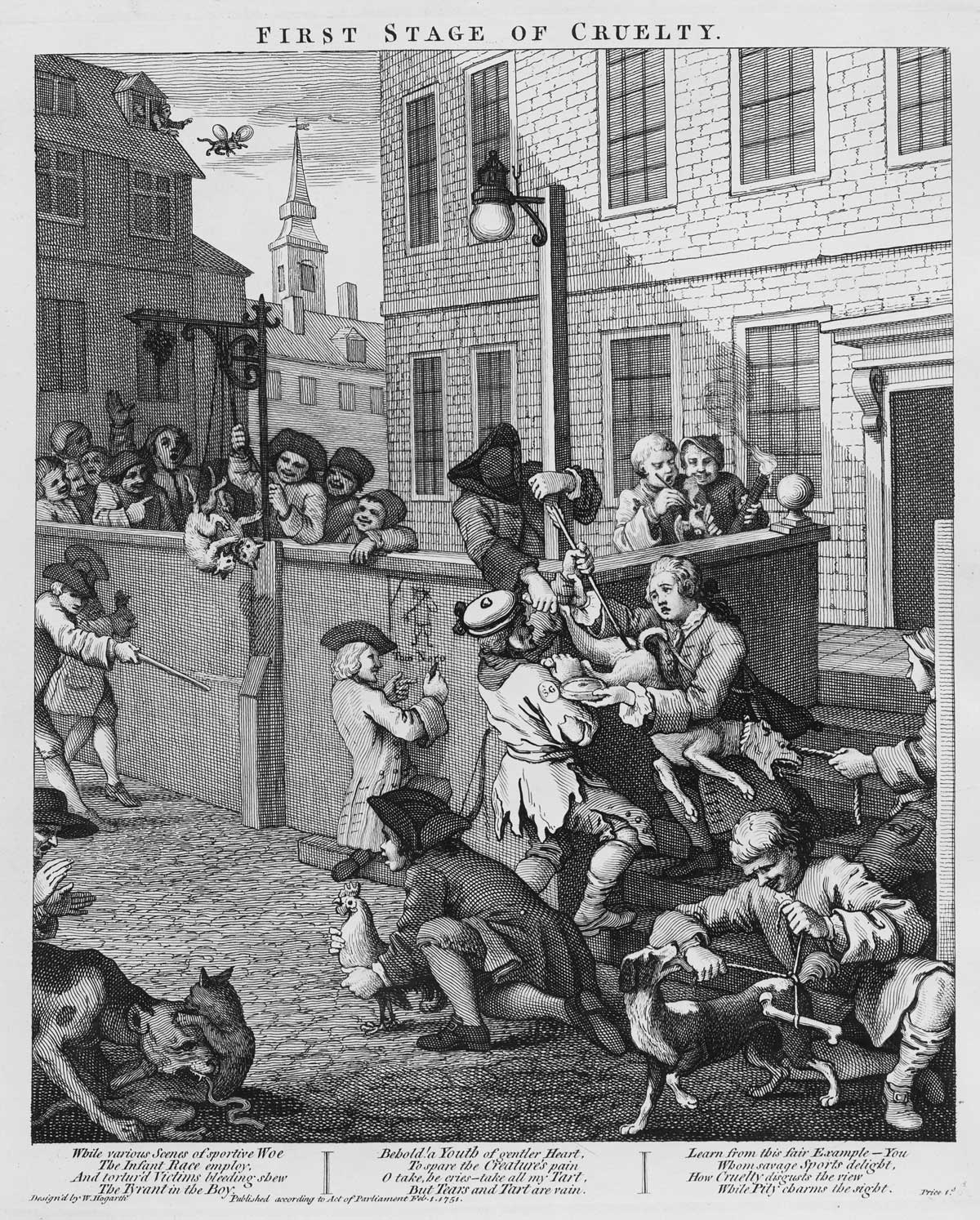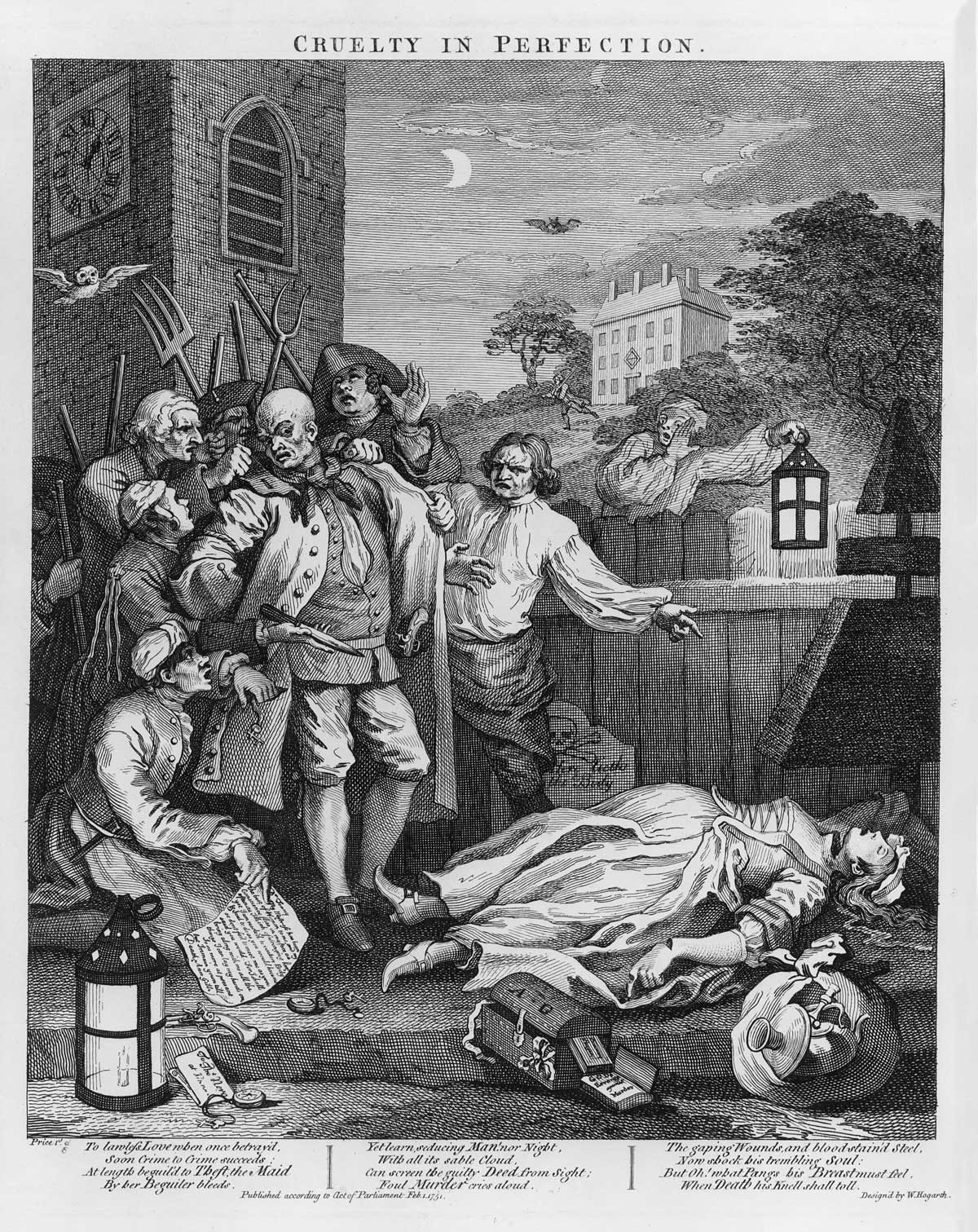A Donkey’s Day in Court
In 1822 a badly abused donkey became the first animal to receive justice in a British court.

There were gasps as the victim was led into court. Some laughed. Clerks whispered excitedly. The defendant, Bill Burns, was appalled. Putting his thumb to his nose, he blew a loud raspberry. But of the victim’s injuries there was no doubt. As a contemporary painting shows, ribs could be seen through the flesh; blood matted the hair; long wounds covered the back. Only the prosecuting lawyer, Richard Martin, remained impassive. Holding the donkey’s reins, he knew that Burns’ cruelty had been proved and that the history of animal rights was about to change for ever.
Stages of cruelty
As Martin was painfully aware, animals had never fared well in the British Isles. Despite the long-standing importance of pastoral agriculture, the growing intensity of farming and the popularity of blood sports had fostered a culture of cruelty. By the late 16th century all manner of abuse could be seen in London. Quite apart from the markets, where slaughter and beatings were an everyday occurrence, there were many sites around the city where curious visitors could see everything from cock throwing and dog fights to bull baiting and monkey gladiators. People from all walks of life shared in the ‘amusement’. Elizabeth I, for example, was reputedly such a fan of dog fights that she bred mastiffs for the purpose. Her successor, James I, founded or enlarged a number of bear pits around the capital. Later, Samuel Pepys described a trip to the Bankside Beargarden as a ‘rude and nasty pleasure’. And in 1675 the Earl of Rochester’s horse was ‘baited to death’ in the Hope Theatre – much to the audience’s delight.
Not everyone had approved, of course. As far back as antiquity, voices had been raised in defence of animals. Although Aristotle had famously viewed them as lesser forms of life, because they lacked thought, reason and belief, Pythagoras had urged compassion, on the basis that human souls ‘migrated’ to animal bodies after death, while Theophrastus had argued that it was better to be a vegetarian than deprive another creature of its life. But it was the Bible which was to prove most influential. In the book of Genesis, Adam and Eve are given dominion over all the beasts of the earth; yet, as the Creation story makes clear, animals are still creatures of God. For many in the British Isles, this ‘Biblical Compromise’ was to prove tremendously important. Particularly for those of an evangelical or puritan bent, it suggested that, while man could kill and eat whatever animal he liked, he was still bound to act as a responsible steward of nature and to treat animals with the consideration they deserved. By extension, it also meant that cruelty to animals was a form of moral degeneracy.
This became a regular refrain. In the mid-16th century the polemicist Robert Crowley wrote a verse bemoaning the folly of keeping ‘A great mastiff dog, and a foul ugly bear’, just to see them fight. Despite their personal fondness for such ‘entertainments’, James I and Charles I banned bear baiting on Sundays, on the grounds that it was out of keeping with the sanctity of the Sabbath; and in 1635 the Irish Parliament banned ‘unusual cruelty’ to animals, principally because it was thought a vice. An equally firm stance was taken by Oliver Cromwell. A lifelong opponent of blood sports, Cromwell banned cock fighting and bear baiting , and did not object when, on 9 February 1656, Colonel Thomas Pride shot the bears at the Hope Theatre to prevent any further moral laxity.
True, by the early 18th century there had been some philosophers who argued that animals should be protected from harm for their own sake, rather than for any transcendental reason. Countering Descartes’ mechanistic view of the universe, which cast ‘unreasoning’ animals as nothing more than soulless machines, John Locke suggested that, since animals could certainly feel pain, for that reason alone they should not be harmed.

But for most animal advocates, such niceties carried little weight. By the time of Richard Martin’s birth in 1754 what mattered was that cruelty was a vice. A vivid illustration of this is provided by William Hogarth’s Four Stages of Cruelty (1751). Here, Hogarth identified cruelty towards animals as the first step on a path to much graver sins. In the first engraving, the anti-hero, Tom Nero, then just a child, inserts a poker into a dog’s anus with the help of a friend. In the second, Nero, now a strapping young coachman, beats his worn-out horse so badly that its eye pops out. In the third, he graduates from hurting animals to the murder of his pregnant lover. And, in the fourth, Nero, having been hanged for his crimes, lies on the dissection table, pored over by surgeons.
Attitudes change
Change was in the air, however. By then the British Isles were already in the grip of the Industrial Revolution. Cotton and textile manufacture were mechanised; great tracts of land were enclosed; rural rents rose; canals were extended; and railways spread. More and more labour became concentrated in urban centres, where living conditions were often extremely poor. Meanwhile, a new class of wealthy bourgeois began to emerge, different in taste and outlook to the landed aristocracy.
This had a marked effect on animals’ place in human society. Although there had always been a certain difference between the activities practised by different social classes, simply because of the nature and cost of the equipment required, the divide now became more pronounced. While hunting and shooting were increasingly dominated by the gentry, ‘traditional’ blood sports, such as cock fighting and bull baiting, became the preserve of the urban working class. At the same time, pet ownership grew rapidly, particularly among the middle classes. Lapdogs were the most popular, but more unusual animals were not unknown. Between the 1730s and the 1750s they enjoyed a vogue among London’s many artisans and shopkeepers. According to one survey, Mr Bradbury the apothecary had a mongoose, while Mrs Kennon the midwife had a ring-tailed lemur and marmoset.
The impact on attitudes towards animal cruelty was profound. As the upper and middle classes retreated from bear pits to grouse moors and drawing rooms, a more sympathetic view of nature took hold. A torrent of writings appeared, defending the consciousness of animals and calling for more ‘humane’ treatment. Among the more noteworthy were Humphry Primatt’s The Duty of Mercy and the Sin of Cruelty to Base Animals (1776) and Thomas Young’s An Essay on Humanity to Animals (1798). As a result, support for animal protection grew – and the demand for legislation became more insistent. But the character of animal advocacy had nevertheless changed. Although cruelty to animals continued to exist at all levels of society, the fact that different socio-economic groups now dominated particular pastimes cloaked moral objections in the mantle of class. Animal advocates – who, with only rare exceptions, tended to come from wealthy, Christian backgrounds – ignored the predilections of their own class and increasingly viewed animal cruelty as a moral failure of the poor alone, akin to drunkenness and prostitution. As a result, attempts to eliminate cruelty to animals were absorbed into wider campaigns to alleviate the moral condition of the poor.
Fury
Resistance to reform nevertheless remained strong. There were still many politicians and landowners who believed that animals were mere property and that to stop a man from beating his own horse to death would be Jacobinism of the worst order. When the Scottish MP William Johnstone Pulteney introduced a bill to ban bull baiting on 18 April 1800, therefore, it provoked a furious response. Although it was defeated by only two votes, it was described by George Canning – a future Foreign Secretary and Prime Minister – as the ‘most absurd bill’ that had ever been placed before the House of Commons. Bizarrely, Canning even suggested that, since bull baiting gave spectators ‘an athletic, vigorous tone’, banning it would actually weaken the nation.

Nine years later Lord Erskine made a second attempt, this time in the House of Lords. A former Lord Chancellor, Erskine was a lifelong animal lover, whose most treasured companions were a parrot, a dog called Toss and a magnificent pair of leeches. He was also more of a realist. Rather than risk provoking another reaction like Canning’s, he focused on prohibiting cruelty to animals with a clear agricultural use, rather than on blood sports per se. To reassure his fellow peers, his bill also included a provision that only the person who harmed an animal would be prosecuted – meaning that the animal’s owner and the perpetrator’s likely employer, would be safe. Erskine’s bill passed in the Lords, but when it was passed back to the Commons it met a frosty reception. Recognising that it might pave the way for wider reforms, more hostile to landowning interests, William Windham, a former Secretary of State for War, used Erskine’s own logic against him. He argued that, since the bill would impose heavy fines on farmers who flogged their donkeys on the road to market, while doing nothing about aristocrats who whipped their horses to death at Ascot, it was really a bill ‘for harassing and oppressing certain classes among the lower order of people’. A majority of MPs agreed.
‘Humanity Dick’
It fell to Richard Martin to take up the cause. Born in Galway to an ambitious Catholic family, Martin had been raised a Protestant so that he could enter politics and had led a decidedly colourful life. A popular figure in high society, he was a passionate theatre-goer, a talented duellist and a noted raconteur. But he was also a spirited defender of the poor, for Catholics and for animals. Indeed, such was his compassion for his fellow creatures that the future George IV even dubbed him ‘Humanity Dick’. In 1821 he tried, and failed, to pass a bill banning cruelty to cattle. Undeterred, he tried again the following year. This time, he set out to prohibit anyone from ‘wantonly beating, abusing, or ill-treating’ farm animals, such as horses, cows, sheep and donkeys. Building on an argument first put forward by Jeremy Bentham a few years earlier, he noted that, since animals could feel pain, they had a right not to be harmed. He was greeted with the usual ridicule. As The Times reported, his tale about a monkey fighting a dog provoked howls of laughter from his fellow MPs. But, such was his charm and wit that his bill sailed through the Commons.
As Martin knew, however, the real challenge was enforcement. While his bill had made it illegal to harm certain animals, it had also stipulated that it was up to private citizens to bring charges before magistrates. Never one to shy away from a challenge, he immediately mounted a case against a London costermonger named Bill Burns, who had been caught thrashing his donkey. Refusing to leave anything to chance, he took the extraordinary decision to lead the donkey into court. So extreme were the poor beast’s injuries that the magistrate had no choice but to find Burns guilty.
It was the first time anyone had ever been convicted of violating an animal’s rights. No longer mere property, at least some beasts now enjoyed the protection of the law and could count on a growing body of allies to defend them. Less than two years later Martin and a group of like-minded friends founded the Society for the Prevention of Cruelty to Animals, dedicated to checking ‘the practice of treating the brute creation with cruelty’. And, while the battle over ‘upper-class’ sports continued to rumble, the society’s campaigns helped to extend legislation to most types of creature. As one popular song put it, Martin’s ‘ass got a verdict’ – not just for itself, but for animals everywhere.
Alexander Lee is a fellow in the Centre for the Study of the Renaissance at the University of Warwick. His latest book, Machiavelli: His Life and Times, is now available in paperback.